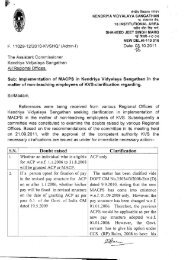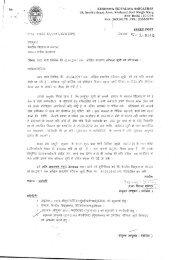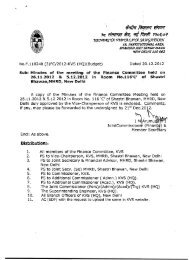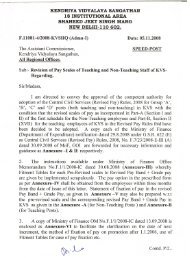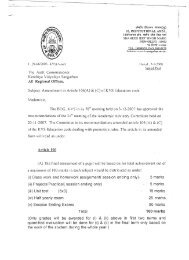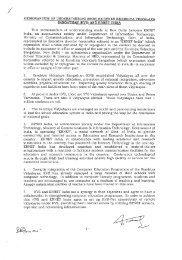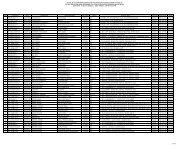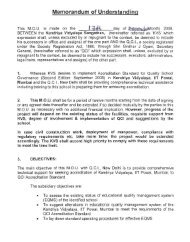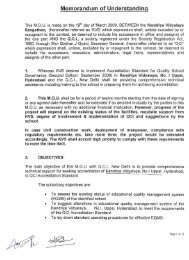Syllabus for written examination for PGT (Biology)
Syllabus for written examination for PGT (Biology)
Syllabus for written examination for PGT (Biology)
You also want an ePaper? Increase the reach of your titles
YUMPU automatically turns print PDFs into web optimized ePapers that Google loves.
standing waves in strings and organ pipes, fundamental mode and harmonics, Beats,Doppler effect.Unit X: ElectrostaticsElectric Charges; Conservation of charge, Coulomb’s law and its application,<strong>for</strong>ce between twopoint charges,<strong>for</strong>ces between multiple charges; superposition principle and continuous charge distribution.Electric field, electric field due to a point charge, electric field lines; electric dipole, electricfield due to a dipole; torque on a dipole in uni<strong>for</strong>m electric field.Gauss’s theorem and its applicationsElectric potential, potential difference, electric potential due to a dipoleand system of charges; equipotential surfaces, electrical potential energy of a system oftwo point charges and of electric dipole in an electrostatic field.Conductors and insulators, free charges and bound charges inside a conductor. Dielectricsand electric polarisation, capacitors and capacitance, combination of capacitors, capacitance ofa parallel plate capacitor with and without dielectric mediumbetween the plates, energy stored in a capacitor. Van de Graaff generator.Unit XI: Current ElectricityElectric current, flow of electric charges in a metallic conductor, drift velocity, mobilityand their relation with electric current; Ohm’s law, electrical resistance, V-I characteristics(linear and non-linear), electrical energy and power, electrical resistivity and conductivity.Carbon resistors, colour code <strong>for</strong> carbon resistors; series and parallel combinations ofresistors; temperature dependence of resistance.Internal resistance of a cell, potential difference and emf of a cell, combination of cells inseries and in parallel.Kirchhoff’s laws and its applications..Potentiometer - principle and its applicationsThermal and chemical effect of current.Unit XII: Magnetic Effects of Current and MagnetismBiot - Savart law and its applicationAmpere’s law and its applications to infinitely long straight wire, straight and toroidalsolenoids.Lorentz’s <strong>for</strong>ce. Cyclotron,synchrotron.Interaction of a current-carrying conductor with magnetic field. Force between twoparallel current-carrying conductors. Torque experienced by a currentloop in uni<strong>for</strong>m magnetic field and its application;Current loop as a magnetic dipole and its magnetic dipole moment. Magnetic dipole momentofa revolving electron. Magnetic field intensity due to a magnetic dipole (bar magnet)along its axis and perpendicular to its axis. Torque on a magnetic dipole (bar magnet) in auni<strong>for</strong>m magnetic field; bar magnet as an equivalent solenoid, magnetic field lines; Earth’smagnetic field and magnetic elements. Para-, dia- and ferro - magnetic substances, withexamples. Electromagnets and factors affecting their strengths. Permanent magnets.Unit XIII: Electromagnetic Induction and Alternating CurrentsElectromagnetic induction; Faraday’s law, induced emf and current; Lenz’s Law, Eddycurrents. Self and mutual inductance.Need <strong>for</strong> displacement current.Alternating currents and its measurement reactance andimpedance; LC oscillations, LCR series circuit, resonance;power in AC circuits,.generator , motors and trans<strong>for</strong>mer.UnitXIV: OpticsReflection of light, spherical mirrors, mirror <strong>for</strong>mula. Refraction of light, total internalreflection and its applications, optical fibres, refraction at spherical surfaces, lenses, thinlens <strong>for</strong>mula, lens-maker’s <strong>for</strong>mula. Magnification, power of a lens, combination of thinlenses in contact. Refraction and dispersion of light through a prism.Scattering of light and its application.Optical instruments: Human eye-eye defects and its correction. Microscopesand astronomical telescopes and their magnifying powers.Wave optics: wave front and Huygens’ principle, reflection and refraction of plane wave ata plane surface using wave fronts. Proof of laws of reflection and refraction using Huygens’principle. Interference, Young’s double slit experiment and expression <strong>for</strong> fringe width,coherent sources and sustained interference of light. Diffraction due to a single slit, width ofcentral maximum. Resolving power of microscopes and astronomical telescopes. Polarisation,plane polarised light; Brewster’s law, uses of plane polarised light and Polaroids.Unit XV: Modern PhysicsDual nature of radiation. Photoelectric effect, Hertz and Lenard’s observations; Einstein’sphotoelectric equation-particle nature of light. Compton effect, deffraction of X- rays ,Bragg’slaw ,Hall effect.Matter waves-wave nature of particles, de Broglie relation. Davisson-Germer experiment.Alpha-particle scattering experiment; Ruther<strong>for</strong>d’s model of atom; Bohr model, energylevels, hydrogen spectrum.Composition and size of nucleus, packing fraction and magnetic moment, atomic masses,isotopes, isobars; isotones. Radioactivity-alpha,beta and gamma particles/rays and their properties; radioactive decay law.Mass-energy relation, mass defect; binding energy per nucleon and its variation with massnumber; liquid drop model of nucleus, nuclear fission and fusion.,critical mass ,chain reaction



